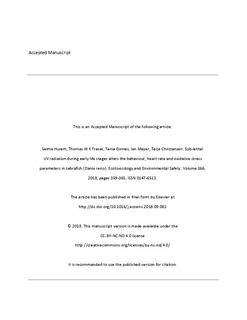| dc.contributor.author | Hurem, Selma | |
| dc.contributor.author | Fraser, Thomas WK | |
| dc.contributor.author | Gomes, Tania | |
| dc.contributor.author | Mayer, Ian | |
| dc.contributor.author | Christensen, Terje | |
| dc.date.accessioned | 2019-07-09T12:20:23Z | |
| dc.date.available | 2019-07-09T12:20:23Z | |
| dc.date.created | 2018-10-23T12:44:58Z | |
| dc.date.issued | 2018 | |
| dc.identifier.citation | Ecotoxicology and Environmental Safety. 2018, 166 359-365. | nb_NO |
| dc.identifier.issn | 0147-6513 | |
| dc.identifier.uri | http://hdl.handle.net/11250/2603935 | |
| dc.description.abstract | Environmental UV radiation in sufficient doses, as a possible consequence of climate change, is potent enough to affect living organisms with different outcomes, depending on the exposure life stage. The aim of this project was to evaluate the potentially toxic effects of exposure to sub-lethal and environmentally relevant doses of UVA (9.4, 18. 7, 37.7 J/cm2) and UVB radiation (0.013, 0.025, 0.076 J/cm2) on the development and behaviour in early life stages (4.5–5.5 h post fertilization, hpf) of the zebrafish (Danio rerio). The used doses were all below the median lethal dose (LD50) and caused no significant difference in survival, deformities, or hatching between exposed and control groups. Compared to controls, there were transient UVA and UVB exposure effects on heart rate, with dose dependent reductions at 50 hpf, and at 60 hpf for UVA only. The UVB exposure caused an increasing trend in reactive oxygen species (ROS) formation at the two highest doses, even though only significant at 120 hpf for the second highest dose. Both UVA and UVB caused an increasing trend in lipid peroxidation (LPO) at the highest doses tested at 72 hpf. Furthermore, UVA exposure led to significant reductions in larval movement following exposure to the two highest doses of UVA, i.e., reduction in the time spent active and the total distance moved compared to control at 100 hpf, while no effect on the swimming speed was observed. The lowest dose of UVA had no effect on behaviour. In contrast, the highest dose of UVB led to a possible increase in the time spent active and a slower average swimming speed although these effects were not significant (p = 0.07). The obtained results show that UV doses below LD50 levels are able to cause changes in the behaviour and physiological parameters of zebrafish larvae, as well as oxidative stress in the form of ROS formation and LPO. Further testing is necessary to assess how this type of radiation and the effects observed could affect fish population dynamics. | nb_NO |
| dc.description.abstract | Sub-lethal UV radiation during early life stages alters the behaviour, heart rate and oxidative stress parameters in zebrafish (Danio rerio) | nb_NO |
| dc.language.iso | eng | nb_NO |
| dc.rights | Attribution-NonCommercial-NoDerivatives 4.0 Internasjonal | * |
| dc.rights.uri | http://creativecommons.org/licenses/by-nc-nd/4.0/deed.no | * |
| dc.title | Sub-lethal UV radiation during early life stages alters the behaviour, heart rate and oxidative stress parameters in zebrafish (Danio rerio) | nb_NO |
| dc.title.alternative | Sub-lethal UV radiation during early life stages alters the behaviour, heart rate and oxidative stress parameters in zebrafish (Danio rerio) | nb_NO |
| dc.type | Journal article | nb_NO |
| dc.type | Peer reviewed | nb_NO |
| dc.description.version | acceptedVersion | nb_NO |
| dc.source.pagenumber | 359-365 | nb_NO |
| dc.source.volume | 166 | nb_NO |
| dc.source.journal | Ecotoxicology and Environmental Safety | nb_NO |
| dc.identifier.doi | 10.1016/j.ecoenv.2018.09.082 | |
| dc.identifier.cristin | 1622635 | |
| dc.relation.project | Norges forskningsråd: 223268 | nb_NO |
| cristin.unitcode | 192,16,2,0 | |
| cristin.unitcode | 192,16,3,0 | |
| cristin.unitcode | 192,14,0,0 | |
| cristin.unitname | Institutt for mattrygghet og infeksjonsbiologi | |
| cristin.unitname | Institutt for produksjonsdyrmedisin | |
| cristin.unitname | Miljøvitenskap og naturforvaltning | |
| cristin.ispublished | true | |
| cristin.fulltext | postprint | |
| cristin.qualitycode | 1 | |

